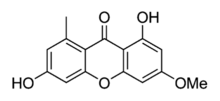 | |
| Names | |
|---|---|
| IUPAC name 1,6-Dihydroxy-3-methoxy-8-methylxanthen-9-one | |
| Identifiers | |
| CAS Number | |
| 3D model (JSmol) | |
| ChEBI | |
| ChEMBL | |
| ChemSpider | |
| PubChem CID | |
| UNII | |
| CompTox Dashboard (EPA) | |
InChI
| |
SMILES
| |
| Properties | |
| Chemical formula | C15H12O5 |
| Molar mass | 272.256 g·mol |
| Appearance | yellowish needles |
| Melting point | 253–255 °C (487–491 °F; 526–528 K) |
| Except where otherwise noted, data are given for materials in their standard state (at 25 °C , 100 kPa). Infobox references | |
Griseoxanthone C is an organic compound in the structural class of chemicals known as xanthones. Its chemical formula is 1,6-dihydroxy-3-methoxy-8-methylxanthen-9-one, and its molecular formula is C15H12O5. It is found in a plant and some fungi, including a lichen.
History
Griseoxanthone C was first isolated from the fungus Penicillium patulum by McMaster and colleagues in 1960. They were investigating the biosynthesis of the somewhat structurally related compound griseofulvin and discovered it in the residual material of the growth medium containing the fungi. A year later, another group studying griseofulvin biosynthesis discovered that the production of griseoxanthone C could be induced by inhibiting the chlorination of griseophenone C (an intermediate in the biosynthetic pathway leading to griseofulvin), and that griseoxanthone C could be created chemically from griseophenone C. Jayalakshmi and colleagues proposed a chemical synthesis of griseoxanthone C in 1974.
Properties
In its purified form, griseoxanthone C exists as yellowish needles with a melting point of 253–255 °C (487–491 °F). An ethanolic solution of griseoxanthone C reacts with iron(III) chloride to produce a violet-brown colour. Its ultraviolet spectrum has four peaks of maximum absorption (λmax) at 242, 269, 309, and 340 nm.
In laboratory tests, griseoxanthone C showed strong antibiotic effects toward Bacillus subtilis and methicillin-resistant Staphylococcus aureus. It also has strong cytotoxicity to Hep2 liver cancer cells in in vitro experiments.
Occurrence
In 1992, John Elix and Caroline Crook reported griseoxanthone C from the lichen Lecanora vinetorum. It has since been reported from various other species, including the flowers of the plant Ficus hookeriana, the fungi Fusarium equiseti, Penicillium concentricum, and Urocladium.
See also
References
- McMaster, W.J.; Scott, A.I.; Trippett, S. (1960). "894. Metabolic products of Penicillium patulum". Journal of the Chemical Society (Resumed): 4628–4361. doi:10.1039/jr9600004628.
- Rhodes, A.; Boothroyd, B.; McGonagle, M.P.; Somerfield, G.A. (1961). "Biosynthesis of griseofulvin: the methylated benzophenone intermediates". Biochemical Journal. 81 (1): 28–37. doi:10.1042/bj0810028. PMC 1243292. PMID 14491779.
- Jayalakshmi, V.; Seshadri, T.R.; Neelakantan, S.; Thillaichidambaram, N. (1974). "Synthesis of griseoxanthone-C". Indian Journal of Chemistry. 12: 441–443.
- Huneck, Siegfried (1996). Identification of Lichen Substances. Berlin, Heidelberg: Springer Berlin Heidelberg. p. 210. ISBN 978-3-642-85245-9. OCLC 851387266.
- ^ Wang, Quan-Xin; Bao, Li; Yang, Xiao-Li; Guo, Hui; Yang, Rui-Nan; Ren, Biao; Zhang, Li-Xin; Dai, Huan-Qin; Guo, Liang-Dong; Liu, Hong-Wei (2012). "Polyketides with antimicrobial activity from the solid culture of an endolichenic fungus Ulocladium sp". Fitoterapia. 83 (1): 209–214. doi:10.1016/j.fitote.2011.10.013. PMID 22061662.
- Hawas, Usama W.; Farrag, Abdel Razik H.; Ahmed, Eman F.; Abou El-Kassem, Lamia T. (2018). "Cytotoxic effect of Fusarium equiseti fungus metabolites against N-nitrosodiethylamine- and CCL4-induced hepatocarcinogenesis in rats". Pharmaceutical Chemistry Journal. 52 (4): 326–333. doi:10.1007/s11094-018-1816-3. S2CID 49868998.
- Elix, John A.; Crook, Caroline E. (1992). "The joint occurrence of chloroxanthones in lichens, and a further thirteen new lichen xanthones". The Bryologist. 95 (1): 52–64. doi:10.2307/3243785. JSTOR 3243785.
- Wei, Gui Qiong; Zheng, Rong; Yang, Xiao Hong (2012). "Extraction and the chemical composition analysis of the essential oil flowers of Ficus hookeriana Corner". Advanced Materials Research. 581–582. Trans Tech Publications, Ltd.: 94–99. doi:10.4028/www.scientific.net/amr.581-582.94. S2CID 96296834.
- Hawas, Usama; Al-Farawati, Radwan; Abou El-Kassem, Lamia; Turki, Adnan (2016). "Different culture metabolites of the Red Sea fungus Fusarium equiseti optimize the inhibition of Hepatitis C virus NS3/4A protease (HCV PR)". Marine Drugs. 14 (10): 190. doi:10.3390/md14100190. PMC 5082338. PMID 27775589.
- Ali, Tehane; Inagaki, Masanori; Chai, Hee-byung; Wieboldt, Thomas; Rapplye, Chad; Rakotondraibe, L. Harinantenaina (2017). "Halogenated compounds from directed fermentation of Penicillium concentricum, an endophytic fungus of the liverwort Trichocolea tomentella". Journal of Natural Products. 80 (5): 1397–1403. doi:10.1021/acs.jnatprod.6b01069. PMID 28409637.